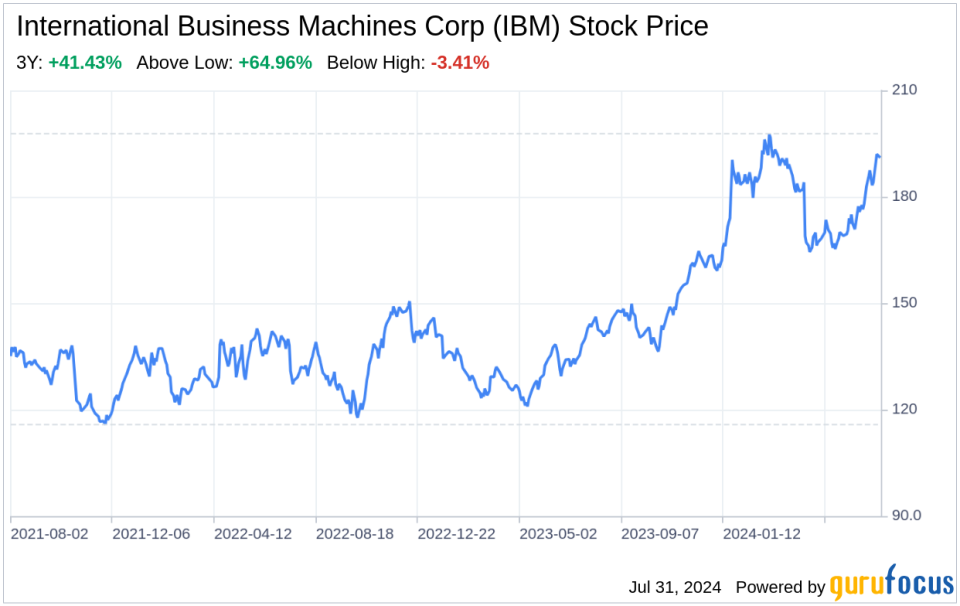Bussiness
Decoding International Business Machines Corp (IBM): A Strategic SWOT Insight

-
IBM’s revenue growth and strategic acquisitions signal robust market positioning.
-
Investments in AI and hybrid cloud services are poised to drive future growth.
-
Legal challenges and competitive pressures remain key considerations for investors.
International Business Machines Corp (NYSE:IBM) released its 10-Q filing on July 30, 2024, providing a detailed look into the company’s financial performance and strategic direction. The filing reveals a company that is deeply integrated into the global IT infrastructure, managing a significant portion of the world’s credit card transactions and wireless connections. With a workforce of approximately 350,000 and operations in 175 countries, IBM’s financials reflect its expansive reach and influence. The company reported a net income of $1,834 million for the three months ended June 30, 2024, marking an increase from $1,583 million in the same period in 2023. Total revenue for the six months ended June 30, 2024, stood at $30,231 million, up from $29,727 million in the previous year, indicating steady growth. This financial overview sets the stage for a comprehensive SWOT analysis, highlighting IBM’s strengths, weaknesses, opportunities, and threats as it navigates the complex landscape of enterprise IT needs.

Strengths
Market Leadership and Brand Reputation: IBM’s brand is synonymous with innovation and reliability in the technology sector. The company’s market leadership is evidenced by its extensive global presence and the trust placed in it by 95% of the Fortune 500 companies. IBM’s ability to manage 90% of all credit card transactions globally showcases its dominance in the IT services market. This strength is further reinforced by its strategic acquisitions, such as the recent purchase of StreamSets and webMethods from Software AG, which enhance IBM’s data platform and integration services.
Robust Financial Performance: IBM’s financial health is a testament to its operational efficiency and strategic initiatives. The company’s increase in net income and revenue, as reported in the latest 10-Q filing, demonstrates its ability to grow and generate profits consistently. The growth in the Software segment, particularly from Hybrid Platform & Solutions led by Red Hat and Automation, reflects the demand for IBM’s high-value offerings. The segment’s profit margin increase to 31.3% in the second quarter of 2024, up from 27.7% in the prior-year period, indicates strong operating leverage and effective cost management.
Weaknesses
Legal and Regulatory Challenges: IBM is subject to various legal and regulatory challenges that could impact its operations and financials. The ongoing lawsuit with GlobalFoundries U.S. Inc. and the tax disputes in Brazil, with potential exposure of approximately $400 million, exemplify the legal risks IBM faces. These issues not only pose financial risks but also distract management from core business activities and could potentially harm the company’s reputation.
Competitive Pressures: The technology industry is characterized by rapid innovation and intense competition. IBM operates in a market with formidable competitors, including newer, more agile firms that challenge its market share. While IBM has made significant investments in areas like AI and cloud computing, it must continuously innovate and adapt to maintain its competitive edge and prevent erosion of its market position.
Opportunities
Expansion in AI and Hybrid Cloud: IBM’s focus on AI and hybrid cloud services presents significant growth opportunities. The company’s AI strategy, including the introduction of watsonx and generative AI, positions it to capitalize on the increasing demand for AI-driven productivity. IBM’s commitment to open-source AI, as demonstrated by the open-sourcing of its Granite family of large language models, aligns with industry trends favoring open innovation ecosystems.
Strategic Partnerships and Acquisitions: IBM’s strategic partnerships and acquisitions, such as the intent to acquire HashiCorp, Inc., are poised to enhance its product and service offerings. These moves can help IBM address growing application and infrastructure complexity, creating a comprehensive end-to-end hybrid cloud platform designed for the AI era. Such initiatives can expand IBM’s total addressable market and drive long-term growth.
Threats
Economic Uncertainty: Global economic uncertainty, including fluctuations in currency exchange rates and interest rates, can impact IBM’s financial performance. The company’s international operations expose it to risks associated with geopolitical tensions and economic downturns in key markets, which could affect client spending and investment in IT services.
Technological Disruption: The rapid pace of technological change poses a threat to IBM’s existing business models. Disruptive technologies, such as quantum computing and blockchain, could render some of IBM’s offerings obsolete if the company does not stay at the forefront of innovation. Additionally, cybersecurity threats are an ever-present concern, with potential to disrupt operations and erode client trust.
In conclusion, IBM’s SWOT analysis reveals a company with a strong market position, bolstered by a robust financial performance and strategic investments in AI and hybrid cloud services. However, it must navigate legal challenges, competitive pressures, and the risks posed by economic uncertainty and technological disruption. IBM’s ability to leverage its strengths and opportunities while effectively managing its weaknesses and threats will be critical to its continued success in the dynamic IT industry.
This article, generated by GuruFocus, is designed to provide general insights and is not tailored financial advice. Our commentary is rooted in historical data and analyst projections, utilizing an impartial methodology, and is not intended to serve as specific investment guidance. It does not formulate a recommendation to purchase or divest any stock and does not consider individual investment objectives or financial circumstances. Our objective is to deliver long-term, fundamental data-driven analysis. Be aware that our analysis might not incorporate the most recent, price-sensitive company announcements or qualitative information. GuruFocus holds no position in the stocks mentioned herein.
This article first appeared on GuruFocus.










